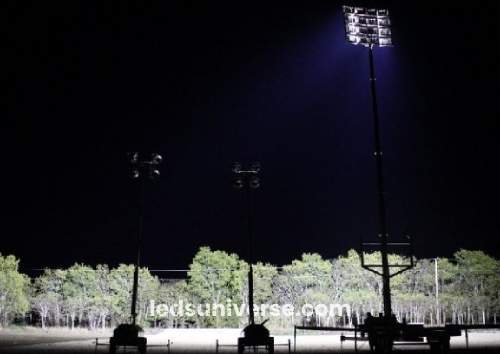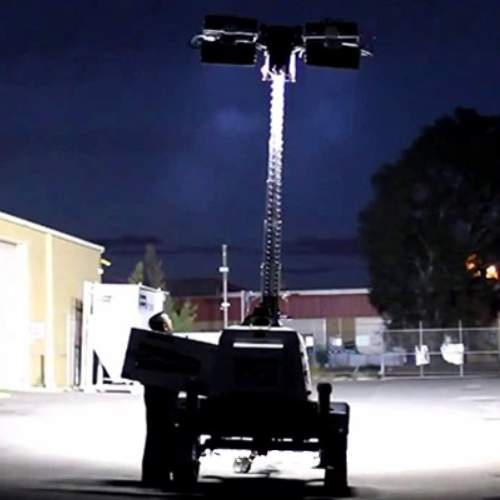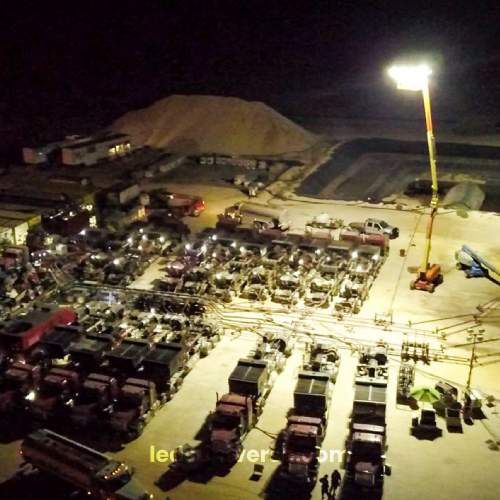As day turns to night, mobile tower lighting steps in to illuminate possibilities. From brightening a busy construction site after dark to transforming a sports field into a nighttime arena or enhancing the ambiance of a lively event, these portable lights bring both function and flair to any setting. Mobile tower lighting ensures that even when the sun sets, activity and progress continue, turning darkness into a canvas of opportunity.
Mobile tower lighting is a versatile solution designed to provide temporary illumination in various settings, from sports fields and outdoor events to construction sites and emergency situations. These portable lighting systems offer a crucial advantage: the ability to deliver focused and adjustable light where and when it’s needed. This flexibility contrasts sharply with permanent lighting installations, which are often limited by their fixed locations and configurations. Understanding mobile tower lighting’s features and benefits can help in selecting the right system for specific needs.
Reach out for free lighting consultation
Table of Contents
Toggle
Traditional diesel-powered lighting towers are among the most common types of mobile lighting solutions. These towers typically consist of a generator that powers high-intensity metal halide lamps mounted on a telescoping mast. Diesel-powered units are renowned for their robustness and high light output, making them suitable for large-scale applications such as sports fields and construction sites. However, they do come with notable disadvantages. Diesel engines can be noisy and produce exhaust fumes, which may be a concern in sensitive environments. Additionally, the ongoing cost of fuel and maintenance can add up over time.
Electric-powered lighting towers represent a more environmentally friendly option compared to their diesel counterparts. These units are powered by electric generators or directly from the grid, using high-efficiency LED or halogen lights. Electric-powered towers are quieter and produce no emissions, which makes them ideal for use in residential areas or indoor settings where noise and air quality are a concern. However, their reliance on a stable power source can limit their usability in remote or off-grid locations.
Solar-powered lighting towers are an innovative solution that harnesses solar energy to power LED lights. These units are equipped with solar panels that charge batteries during the day, providing illumination during the night. Solar-powered towers offer a sustainable and low-maintenance option, reducing the need for fuel and lowering operating costs. They are particularly beneficial in areas with ample sunlight and are increasingly used in various applications, from remote construction sites to outdoor events. The main drawback is their reliance on weather conditions; insufficient sunlight can limit their performance.
Hybrid lighting towers combine multiple power sources to enhance reliability and flexibility. These models typically integrate solar panels with diesel or electric generators, allowing them to switch between power sources as needed. Hybrid systems aim to balance the benefits of renewable energy with the reliability of traditional power sources. They offer extended operation times and reduced fuel consumption compared to purely diesel-powered units. However, the complexity of hybrid systems can lead to higher initial costs and maintenance requirements.

Measured in lumens, this capacity indicates the brightness and coverage area provided by the lights. High-capacity towers are essential for large outdoor spaces, such as sports fields, where uniform illumination is necessary to ensure visibility and safety. The choice of lighting capacity depends on the specific requirements of the site, including the size of the area and the nature of the activities being conducted.
The height of the lighting tower and its adjustability are crucial for achieving optimal illumination. Most mobile lighting towers feature a telescoping mast that can be extended to increase the height of the lights, ensuring better coverage and reducing shadows. Adjustable height also allows for customization based on the specific needs of the application, such as varying the intensity of light for different sports or events. Stability features, such as outriggers or stabilizing legs, are important to ensure that the tower remains secure during operation.
The power source of a mobile lighting tower significantly impacts its operational efficiency and suitability. Diesel-powered towers offer high power output and are suitable for extended use in areas without access to electricity. Electric-powered towers rely on grid or generator power and are ideal for environments with stable electricity access. Solar-powered towers utilize renewable energy, providing a sustainable option with minimal ongoing costs. Hybrid models offer a combination of power sources, enhancing flexibility and reducing reliance on any single source.
Portability is a key advantage of mobile lighting towers, enabling easy transportation and setup at different locations. Factors such as size, weight, and ease of maneuverability affect how easily a lighting tower can be moved. Compact and lightweight models are easier to transport, while those with built-in wheels or trailers can be relocated more efficiently. The design of the tower should also facilitate quick assembly and disassembly to maximize usability and minimize downtime.
Durability and weather resistance are essential considerations for mobile lighting towers, especially when used in harsh environments. Towers are typically constructed from rugged materials designed to withstand physical impacts and adverse weather conditions. Features such as corrosion-resistant coatings and waterproof enclosures protect the lighting components from rain, dust, and extreme temperatures. Ensuring that the tower can endure the conditions it will be exposed to is critical for maintaining performance and extending its operational lifespan.
Mobile tower lighting is frequently used in sports fields to provide adequate illumination for evening games and practice sessions. Different sports have varying lighting requirements; for example, football fields may need higher intensity and broader coverage compared to tennis courts. Proper lighting enhances visibility for players and spectators, ensuring safety and improving the overall experience. Mobile towers offer the flexibility to adjust lighting setups based on the specific needs of each sport, making them a valuable tool for sports facilities.
Outdoor events and fairs often require temporary lighting to create a safe and enjoyable environment for attendees. Mobile lighting towers can illuminate large areas, such as event grounds, vendor stalls, and pathways, ensuring visibility and enhancing the ambiance. The ability to quickly deploy and adjust lighting makes mobile towers ideal for temporary setups, accommodating various event sizes and types. Additionally, the option to use solar-powered or hybrid models can reduce operating costs and environmental impact.

In construction sites, mobile lighting towers are essential for ensuring safety and productivity during nighttime operations. Adequate lighting is necessary for tasks such as excavation, building, and inspection, helping to prevent accidents and improve work conditions. The ability to move and reposition lighting towers allows for flexible lighting solutions tailored to different areas of the site. Durability and weather resistance are particularly important, as construction sites often involve exposure to harsh conditions.
Mobile lighting towers are invaluable in emergency and temporary situations where reliable illumination is needed quickly. In disaster relief scenarios, these towers can provide lighting for search and rescue operations, temporary shelters, and medical facilities. Their portability and ease of setup make them suitable for use in rapidly changing environments. The flexibility to switch between power sources, as offered by hybrid and solar models, further enhances their utility in emergency situations.
One of the primary advantages of mobile tower lighting is its flexibility and versatility. These systems can be easily moved and adjusted to meet the specific lighting needs of different locations and applications. Whether it’s a sports field, a construction site, or an outdoor event, mobile lighting towers can be adapted to provide the necessary illumination. This adaptability ensures that lighting requirements are met efficiently, without the need for permanent installations.
Mobile lighting towers can be a cost-effective solution compared to permanent lighting installations. While the initial investment in a mobile lighting system may be significant, the ability to use and relocate the equipment for various applications can offset these costs over time. Additionally, options such as solar-powered or hybrid models can reduce ongoing operational expenses related to fuel and electricity. For temporary needs or short-term projects, mobile lighting towers offer a financially advantageous alternative.
The ease of use and setup of mobile lighting towers contribute to their appeal for various applications. Most units are designed with user-friendly features, such as intuitive controls and quick assembly mechanisms. This simplicity allows for rapid deployment and adjustment, minimizing downtime and maximizing operational efficiency. The convenience of mobile lighting towers ensures that they can be effectively utilized in a wide range of scenarios, from routine events to emergency situations.
The environmental impact of mobile lighting towers varies depending on the power source and design. Solar-powered and hybrid models offer a sustainable option by reducing reliance on fossil fuels and lowering emissions. These systems contribute to a smaller carbon footprint and support environmental conservation efforts. In contrast, diesel-powered towers have a higher environmental impact due to fuel consumption and emissions. Choosing energy-efficient models and renewable energy sources can help mitigate the environmental effects of mobile lighting.
Selecting the right mobile lighting tower involves assessing the specific lighting requirements of the application. Factors such as the size of the area, the intensity of light needed, and the duration of use should be considered. For large spaces, higher-capacity lighting towers may be necessary to ensure adequate coverage. It’s important to match the lighting capacity and features of the tower to the demands of the project or event to achieve optimal results.
The choice of power and fuel options influences the performance and cost of mobile lighting towers. Diesel-powered towers are suitable for extended use in locations without electricity access but may incur higher fuel and maintenance costs. Electric-powered towers are ideal for areas with reliable power sources but may be limited by their dependency on electricity. Solar-powered and hybrid models offer sustainable alternatives with lower operational costs. Evaluating the available power options and their compatibility with the intended use is crucial for making an informed decision.
Budget constraints play a significant role in selecting a mobile lighting tower. While initial costs can vary based on the type and features of the tower, it’s important to consider long-term expenses, including fuel, maintenance, and potential repairs. Balancing the initial investment with ongoing costs and benefits will help determine the most cost-effective solution. Exploring different models and their associated costs can aid in finding a lighting tower that fits within the budget while meeting the required specifications.
Maintenance and support are essential factors to consider when choosing a mobile lighting tower. Regular upkeep is necessary to ensure the tower operates efficiently and has a long service life. Availability of spare parts, technical support, and service options can impact the overall usability and reliability of the system. Opting for a manufacturer or supplier that offers comprehensive support and maintenance services can help address any issues promptly and maintain the performance of the lighting tower.
Mobile tower lighting offers a flexible and effective solution for temporary illumination needs across various applications. From sports fields and outdoor events to construction sites and emergency situations, these portable systems provide essential lighting where and when it’s needed. Understanding the different types of mobile lighting towers, their features, and their applications can help in selecting the most suitable system for specific requirements. As technology continues to advance, mobile lighting towers will evolve to offer even greater efficiency, sustainability, and convenience. By considering factors such as lighting capacity, power sources, and budget constraints, users can make informed decisions and ensure that their lighting needs are met effectively.